Alpha Centauri
 Alpha Centauri AB is the bright star to the left, which forms a triple star system with Proxima Centauri, circled in red. The bright star system to the right is Beta Centauri. | |
| Observation data Epoch J2000.0 Equinox J2000.0 | |
|---|---|
| Constellation | Centaurus |
| Alpha Centauri A | |
| Right ascension | 14h 39m 36.49400s [1] |
| Declination | −60° 50′ 02.3737″ |
| Apparent magnitude (V) | +0.01 [2] |
| Alpha Centauri B | |
| Right ascension | 14h 39m 35.06311s [1] |
| Declination | −60° 50′ 15.0992″ |
| Apparent magnitude (V) | +1.33 [2]
|
| Characteristics | |
| A | |
| Spectral type | G2V [3] |
| U−B color index | +0.24 |
| B−V color index | +0.71[2] |
| B | |
| Spectral type | K1V [3] |
| U−B color index | +0.68 |
| B−V color index | +0.88 [2] |
| Astrometry | |
| A | |
| Radial velocity (Rv) | −21.4±0.76 [4] km/s |
| Proper motion (μ) | RA: −3679.25 mas/yr Dec.: 473.67 mas/yr |
| Parallax (π) | 750.81 ± 0.38[5] mas |
| Distance | 4.37 [6] ly |
| Absolute magnitude (MV) | 4.38 [7] |
| B | |
| Radial velocity (Rv) | −18.6±1.64 [4] km/s |
| Proper motion (μ) | RA: −3614.39 [1] mas/yr Dec.: 802.98 mas/yr |
| Parallax (π) | 750.81 ± 0.38[5] mas |
| Distance | 4.37 [6] ly |
| Absolute magnitude (MV) | 5.71 [7] |
| Details | |
| Alpha Centauri A | |
| Mass | 1.0788±0.0029 [5] M☉ |
| Radius | 1.2175±0.0055 [5] R☉ |
| Luminosity | 1.5059±0.0019[5] L☉ |
| Surface gravity (log g) | 4.30 [8] cgs |
| Temperature | 5,790 K |
| Metallicity [Fe/H] | <0.20 dex |
| Rotation | 22±5.9 d |
| Rotational velocity (v sin i) | 2.7±0.7 [9] km/s |
| Alpha Centauri B | |
| Mass | 0.9092±0.0025[5] M☉ |
| Radius | 0.8591±0.0036 [5] R☉ |
| Luminosity | 0.4981±0.0007 [5] L☉ |
| Surface gravity (log g) | 4.37 [8] cgs |
| Temperature | 5,260 K |
| Metallicity | 0.23 |
| Rotation | 36 days [10] |
| Rotational velocity (v sin i) | 1.1±0.8 [11] km/s |
| Age | 5.3±0.3 [12] Gyr |
| Orbit[5] | |
| Primary | A |
| Companion | B |
| Period (P) | 79.762±0.019 yr |
| Semi-major axis (a) | 17.493±0.0096″ |
| Eccentricity (e) | 0.51947±0.00015 |
| Inclination (i) | 79.243±0.0089° |
| Longitude of the node (Ω) | 205.073±0.025° |
| Periastron epoch (T) | 1875.66±0.012 |
| Argument of periastron (ω) (secondary) | 231.519±0.027° |
| Other designations | |
| α Cen A: Rigil Kentaurus, Rigil Kent, α1 Centauri, HR 5459, HD 128620, GCTP 3309.00, LHS 50, SAO 252838, HIP 71683 | |
| α Cen B: Toliman, α2 Centauri, HR 5460, HD 128621, LHS 51, HIP 71681 | |
| Database references | |
| SIMBAD | AB |
| A | |
| B | |
| Exoplanet Archive | data |
| ARICNS | data |
| Extrasolar Planets Encyclopaedia | data |
Alpha Centauri is a gravitationally bound system of the closest stars and exoplanets to our Solar System at 4.37 light-years (1.34 parsecs) from the Sun. The name is Latinized from α Centauri, and abbreviated Alpha Cen or α Cen. It is a triple star system consisting of α Centauri A (officially Rigil Kentaurus),[13] α Centauri B (officially Toliman),[13] and the closest star α Centauri C (officially Proxima Centauri).[13]
Alpha Centauri A and B are Sun-like stars (Class G and K, respectively), and together they form the binary star Alpha Centauri AB. To the naked eye, the two main components appear to be a single star with an apparent magnitude of −0.27, the brightest star in the southern constellation of Centaurus and the third-brightest in the night sky, outshone only by Sirius and Canopus.
Alpha Centauri A has 1.1 times the mass and 1.5 times the luminosity of the Sun, while Alpha Centauri B is smaller and cooler, at 0.9 times the Sun's mass and less than 0.5 times its luminosity.[14] The pair orbit around a common centre with an orbital period of 79 years.[15] Their elliptical orbit is eccentric, so that the distance between A and B varies from 35.6 AU (astronomical units), or about the distance between Pluto and the Sun, to 11.2 AU, or about the distance between Saturn and the Sun.
Alpha Centauri C, or Proxima Centauri, is a small faint red dwarf (Class M). Though not visible to the naked eye, Proxima Centauri is the closest star to the Sun at a distance of 4.24 ly (1.30 pc), slightly closer than Alpha Centauri AB. Currently, the distance between Proxima Centauri and Alpha Centauri AB is about 13,000 AU (0.21 ly),[16] equivalent to about 430 times the radius of Neptune's orbit.
Proxima Centauri has three known planets: Proxima b, an Earth-sized exoplanet in the habitable zone discovered in 2016; Proxima c, a super-Earth 1.5 AU away, which is possibly surrounded by a huge ring system, discovered in 2019; and Proxima d, a sub-Earth which orbits very closely to the star, announced in 2022. Alpha Centauri A may have a Neptune-sized habitable-zone planet, though it is not yet known to be planetary in nature and could be an artifact of the discovery mechanism. Alpha Centauri B has no known planets: planet Bb, purportedly discovered in 2012, was found to be an artifact, and a separate transiting planet has yet to be confirmed.
Nomenclature[]

α Centauri (Latinised to Alpha Centauri) is the system's designation given by Johann Bayer in 1603. It bears the traditional name Rigil Kentaurus, which is a Latinisation of the Arabic name رجل القنطورس Rijl al-Qinṭūrus, meaning 'the Foot of the Centaur'.[17][18] The name is frequently abbreviated to Rigil Kent or even Rigil, though the latter name is better known for Beta Orionis (Rigel).[19]
An alternative name found in European sources, Toliman, is an approximation of the Arabic الظليمان aẓ-Ẓalīmān (in older transcription, aṭ-Ṭhalīmān), meaning 'the (two male) Ostriches', an appellation Zakariya al-Qazwini had applied to Lambda and Mu Sagittarii, also in the southern hemisphere.[20]
A third name that has been applied is Bungula (/ˈbʌŋɡjuːlə/), of obscure origin. Allen can only surmise it may have been coined from the Greek letter beta (β) and Latin ungula 'hoof'.[19]
Alpha Centauri C was discovered in 1915 by Robert T. A. Innes,[21] who suggested that it be named Proxima Centaurus,[22] from Latin 'the nearest [star] of Centaurus'.[23] The name Proxima Centauri later became more widely used and is now listed by the International Astronomical Union (IAU) as the approved proper name.[24][25]
In 2016, the Working Group on Star Names of the International Astronomical Union (IAU),[26] having decided to attribute proper names to individual component stars rather than to multiple systems,[27] approved the name Rigil Kentaurus (/ˈraɪdʒəl kɛnˈtɔːrəs/) as being restricted to Alpha Centauri A and the name Proxima Centauri (/ˈprɒksɪmə sɛnˈtɔːraɪ/) for Alpha Centauri C.[13]
On 10 August 2018, the IAU approved the name Toliman (/ˈtɒlɪmæn/) for Alpha Centauri B.[28]
Stellar system[]
Alpha Centauri is a triple star system, with its two main stars, Alpha Centauri A and Alpha Centauri B, together comprising a binary component. The AB designation, or older A×B, denotes the mass centre of a main binary system relative to companion star(s) in a multiple star system.[29] AB-C refers to the component of Proxima Centauri in relation to the central binary, being the distance between the centre of mass and the outlying companion. Because the distance between Proxima (C) and either of Alpha Centauri A or B is similar, the AB binary system is sometimes treated as a single gravitational object.[30]
Orbital properties[]
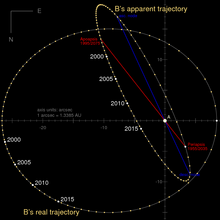
The A and B components of Alpha Centauri have an orbital period of 79.762 years.[5] Their orbit is moderately eccentric, as it has an eccentricity of almost 0.52;[5] their closest approach or periastron is 11.2 AU (1.68×109 km), or about the distance between the Sun and Saturn; and their furthest separation or apastron is 35.6 AU (5.33×109 km), about the distance between the Sun and Pluto.[15] The most recent periastron was in August 1955 and the next will occur in May 2035; the most recent apastron was in May 1995 and will next occur in 2075.
Viewed from Earth, the apparent orbit of A and B means that their separation and position angle (PA) are in continuous change throughout their projected orbit. Observed stellar positions in 2019 are separated by 4.92 arcsec through the PA of 337.1°, increasing to 5.49 arcsec through 345.3° in 2020.[15] The closest recent approach was in February 2016, at 4.0 arcsec through the PA of 300°.[15][32] The observed maximum separation of these stars is about 22 arcsec, while the minimum distance is 1.7 arcsec.[33] The widest separation occurred during February 1976, and the next will be in January 2056.[15]
Alpha Centauri C is about 13,000 AU (0.21 ly; 1.9×1012 km) from Alpha Centauri AB, equivalent to about 5% of the distance between Alpha Centauri AB and the Sun.[16][34][35] Until 2017, measurements of its small speed and its trajectory were of too little accuracy and duration in years to determine whether it is bound to Alpha Centauri AB or unrelated.
Radial velocity measurements made in 2017 were precise enough to show that Proxima Centauri and Alpha Centauri AB are gravitationally bound.[16] The orbital period of Proxima Centauri is approximately 511000+41000
−30000 years, with an eccentricity of 0.5, much more eccentric than Mercury's. Proxima Centauri comes within 4100+700
−600 AU of AB at periastron, and its apastron occurs at 12300+200
−100 AU.[5]
Physical properties[]

Asteroseismic studies, chromospheric activity, and stellar rotation (gyrochronology) are all consistent with the Alpha Centauri system being similar in age to, or slightly older than, the Sun.[36] Asteroseismic analyses that incorporate tight observational constraints on the stellar parameters for the Alpha Centauri stars have yielded age estimates of 4.85±0.5-Gyr,[37] 5.0±0.5-Gyr,[38] 5.2 ± 1.9-Gyr,[39] 6.4-Gyr,[40] and 6.52±0.3-Gyr.[41] Age estimates for the stars based on chromospheric activity (Calcium H & K emission) yield 4.4 ± 2.1-Gyr, whereas gyrochronology yields 5.0±0.3 Gyr.[36] Stellar evolution theory implies both stars are slightly older than the Sun at 5 to 6 billion years, as derived by their mass and spectral characteristics.[34][42]
From the orbital elements, the total mass of Alpha Centauri AB is about 2.0 M☉[note 2] – or twice that of the Sun.[33] The average individual stellar masses are about 1.08 M☉ and 0.91 M☉, respectively,[5] though slightly different masses have also been quoted in recent years, such as 1.14 M☉ and 0.92 M☉,[43] totalling 2.06 M☉. Alpha Centauri A and B have absolute magnitudes of +4.38 and +5.71, respectively.
Alpha Centauri A[]
Alpha Centauri A, also known as Rigil Kentaurus, is the principal member, or primary, of the binary system. It is a solar-like main-sequence star with a similar yellowish colour,[44] whose stellar classification is spectral type G2-V;[3] it is about 10% more massive than the Sun,[37] with a radius about 22% larger.[45] When considered among the individual brightest stars in the sky (excluding the Sun), it is the fourth brightest at an apparent magnitude of −0.01, being slightly fainter than Arcturus at an apparent magnitude of −0.05.
The type of magnetic activity on Alpha Centauri A is comparable to that of the Sun, showing coronal variability due to star spots, as modulated by the rotation of the star. However, since 2005 the activity level has fallen into a deep minimum that might be similar to the Sun's historical Maunder Minimum. Alternatively, it may have a very long stellar activity cycle and is slowly recovering from a minimum phase.[46]
Alpha Centauri B[]
Alpha Centauri B, also known as Toliman, is the secondary star of the binary system. It is a main-sequence star of spectral type K1-V, making it more an orange colour than Alpha Centauri A;[44] it has around 90% of the mass of the Sun and a 14% smaller diameter. Although it has a lower luminosity than A, Alpha Centauri B emits more energy in the X-ray band.[47] Its light curve varies on a short time scale, and there has been at least one observed flare.[47] It is more magnetically active than Alpha Centauri A, showing a cycle of 8.2±0.2 yr compared to 11 years for the Sun, and about half the minimum-to-peak variation in coronal luminosity of the Sun.[46] Alpha Centauri B has an apparent magnitude of +1.35, slightly dimmer than Mimosa (Beta Crucis).[13]
Alpha Centauri C (Proxima Centauri)[]
Alpha Centauri C, better known as Proxima Centauri, is a small main-sequence red dwarf of spectral class M6-Ve. It has an absolute magnitude of +15.60, over 20,000 times fainter than the Sun. Its mass is calculated to be 0.1221 M☉.[48] It is the closest star to the Sun but is too faint to be visible to the naked eye.

Observation[]
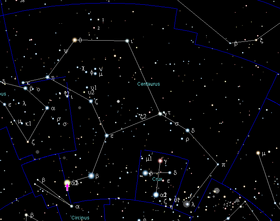
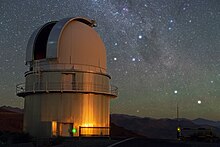
To the naked eye, Alpha Centauri AB appears to be a single star, the brightest in the southern constellation of Centaurus.[50] Their apparent angular separation varies over about 80 years between 2 and 22 arcsec (the naked eye has a resolution of 60 arcsec),[51] but through much of the orbit, both are easily resolved in binoculars or small telescopes.[52] At −0.27 apparent magnitude (combined for A and B magnitudes), Alpha Centauri is fainter only than Sirius and Canopus.[50] It is the outer star of The Pointers or The Southern Pointers,[52] so called because the line through Beta Centauri (Hadar/Agena),[53] some 4.5° west,[52] points to the constellation Crux — the Southern Cross.[52] The Pointers easily distinguish the true Southern Cross from the fainter asterism known as the False Cross.[54]
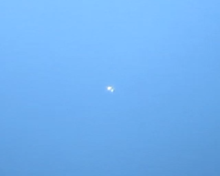
South of about 29° South latitude, Alpha Centauri is circumpolar and never sets below the horizon.[note 3] North of about 29° N latitude, Alpha Centauri never rises. Alpha Centauri lies close to the southern horizon when viewed from the 29° North latitude to the equator (close to Hermosillo, Chihuahua City in Mexico, Galveston, Texas, Ocala, Florida and Lanzarote, the Canary Islands of Spain), but only for a short time around its culmination.[53] The star culminates each year at local midnight on 24 April and at local 9 p.m. on 8 June.[53][55]
As seen from Earth, Proxima Centauri is 2.2° southwest from Alpha Centauri AB, about four times the angular diameter of the Moon.[34] Proxima Centauri appears as a deep-red star of a typical apparent magnitude of 11.1 in a sparsely populated star field, requiring moderately sized telescopes to be seen. Listed as V645 Cen in the General Catalogue of Variable Stars Version 4.2, this UV Ceti-type flare star can unexpectedly brighten rapidly by as much as 0.6 magnitude at visual wavelengths, then fade after only a few minutes.[56] Some amateur and professional astronomers regularly monitor for outbursts using either optical or radio telescopes.[57] In August 2015, the largest recorded flares of the star occurred, with the star becoming 8.3 times brighter than normal on 13 August, in the B band (blue light region).[58]
Alpha Centauri is inside the G-cloud, and its nearest known system is the binary brown dwarf system Luhman 16 at 3.6 ly (1.1 pc).[59]
Observational history[]

Alpha Centauri is listed in the 2nd-century star catalog of Ptolemy. He gave its ecliptic coordinates, but texts differ as to whether the ecliptic latitude reads 44° 10′ South or 41° 10′ South.[60] (Presently the ecliptic latitude is 43.5° South, but it has decreased by a fraction of a degree since Ptolemy's time due to proper motion.) In Ptolemy's time, Alpha Centauri was visible from Alexandria, Egypt, at 31° N, but, due to precession, its declination is now –60° 51′ South, and it can no longer be seen at that latitude. English explorer Robert Hues brought Alpha Centauri to the attention of European observers in his 1592 work Tractatus de Globis, along with Canopus and Achernar, noting:
Now, therefore, there are but three Stars of the first magnitude that I could perceive in all those parts which are never seene here in England. The first of these is that bright Star in the sterne of Argo which they call Canobus [Canopus]. The second [Achernar] is in the end of Eridanus. The third [Alpha Centauri] is in the right foote of the Centaure.[61]
The binary nature of Alpha Centauri AB was recognised in December 1689 by , while observing a passing comet from his station in Puducherry. Alpha Centauri was only the second binary star to be discovered, preceded by Acrux.[62]
The large proper motion of Alpha Centauri AB was discovered by Manuel John Johnson, observing from Saint Helena, who informed Thomas Henderson at the Royal Observatory, Cape of Good Hope of it. The parallax of Alpha Centauri was subsequently determined by Henderson from many exacting positional observations of the AB system between April 1832 and May 1833. He withheld his results, however, because he suspected they were too large to be true, but eventually published them in 1839 after Friedrich Wilhelm Bessel released his own accurately determined parallax for 61 Cygni in 1838.[63] For this reason, Alpha Centauri is sometimes considered as the second star to have its distance measured because Henderson's work was not fully acknowledged at first.[63] (The distance of Alpha Centauri from the Earth is now reckoned at 4.396 ly (41.59×1012 km).)
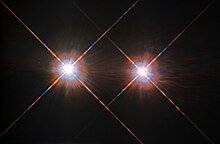
Later, John Herschel made the first micrometrical observations in 1834.[65] Since the early 20th century, measures have been made with photographic plates.[35]
By 1926, William Stephen Finsen calculated the approximate orbit elements close to those now accepted for this system.[33] All future positions are now sufficiently accurate for visual observers to determine the relative places of the stars from a binary star ephemeris.[66] Others, like D. Pourbaix (2002), have regularly refined the precision of new published orbital elements.[15]
Robert T. A. Innes discovered Proxima Centauri in 1915 by blinking photographic plates taken at different times during a proper motion survey. These showed large proper motion and parallax similar in both size and direction to those of Alpha Centauri AB, suggesting that Proxima Centauri is part of the Alpha Centauri system and slightly closer to Earth than Alpha Centauri AB. Lying 4.24 ly (1.30 pc) away, Proxima Centauri is the nearest star to the Sun.
Kinematics[]
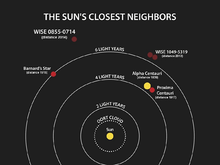
All components of Alpha Centauri display significant proper motion against the background sky. Over centuries, this causes their apparent positions to slowly change.[67] Proper motion was unknown to ancient astronomers. Most assumed that the stars are permanently fixed on the celestial sphere, as stated in the works of the philosopher Aristotle.[68] In 1718, Edmond Halley found that some stars had significantly moved from their ancient astrometric positions.[69]
In the 1830s, Thomas Henderson discovered the true distance to Alpha Centauri by analysing his many astrometric mural circle observations.[70][71] He then realised this system also likely had a high proper motion.[72][73][33] In this case, the apparent stellar motion was found using Nicolas Louis de Lacaille's astrometric observations of 1751–1752,[74] by the observed differences between the two measured positions in different epochs.
Calculated proper motion of the centre of mass for Alpha Centauri AB is about 3620 mas/y (milliarcseconds per year) toward the west and 694 mas/y toward the north, giving an overall motion of 3686 mas/y in a direction 11° north of west.[75][note 4] The motion of the centre of mass is about 6.1 arcmin each century, or 1.02° each millennium. The speed in the western direction is 23.0 km/s (14.3 mi/s) and in the northerly direction 4.4 km/s (2.7 mi/s). Using spectroscopy the mean radial velocity has been determined to be around 22.4 km/s (13.9 mi/s) towards the Solar System.[75] This gives a speed with respect to the Sun of 32.4 km/s (20.1 mi/s), very close to the peak in the distribution of speeds of nearby stars.[76]
Since Alpha Centauri AB is almost exactly in the plane of the Milky Way as viewed from Earth, many stars appear behind it. In early May 2028, Alpha Centauri A will pass between the Earth and a distant red star, when there is a 45% probability that an Einstein ring will be observed. Other conjunctions will also occur in the coming decades, allowing accurate measurement of proper motions and possibly giving information on planets.[75]
Predicted future changes[]


Based on the system's common proper motion and radial velocities, Alpha Centauri will continue to change its position in the sky significantly and will gradually brighten. For example, in about 6,200 AD, α Centauri's true motion will cause an extremely rare first-magnitude stellar conjunction with Beta Centauri, forming a brilliant optical double star in the southern sky.[77] It will then pass just north of the Southern Cross or Crux, before moving northwest and up towards the present celestial equator and away from the galactic plane. By about 26,700 AD, in the present-day constellation of Hydra, Alpha Centauri will reach perihelion at 0.90 pc or 2.9 ly away,[78] though later calculations suggest that this will occur in 27,000 AD.[79] At nearest approach, Alpha Centauri will attain a maximum apparent magnitude of −0.86, comparable to present-day magnitude of Canopus, but it will still not surpass that of Sirius, which will brighten incrementally over the next 60,000 years, and will continue to be the brightest star as seen from Earth (other than the Sun) for the next 210,000 years.[80]
Planetary system[]
The Alpha Centauri system as a whole has three confirmed planets, all of them around Proxima Centauri. While other planets have been claimed to exist around all of the stars, none of the discoveries have been confirmed.
Confirmed planets[]
Proxima Centauri[]
Proxima Centauri b is a terrestrial planet discovered in 2016 by astronomers at the European Southern Observatory (ESO). It has an estimated minimum mass of 1.17 MEarth (Earth masses) and orbits approximately 0.049 AU from Proxima Centauri, placing it in the star's habitable zone (Goldilocks zone).[81][82]
Proxima Centauri c is an exoplanet that was formally discovered in 2020 and could be a super-Earth or mini-Neptune.[83] It has a mass of roughly 7 MEarth and orbits about 1.49 AU from Proxima Centauri with a period of 1,928 days (5.28 yr). In June 2020, a large ring system encircling the planet was possibly detected.[84][85][86] While not formally confirmed, its existence is undisputed.
A 2020 paper refining Proxima b's mass excludes the presence of extra companions with masses above 0.6 MEarth at periods shorter than 50 days, but the authors detected a radial-velocity curve with a periodicity of 5.15 days. While the signal may be related to stellar activity or simply be noise from the detection algorithm, Proxima Centauri d is estimated to have a mass of about 0.29 MEarth.[82]
Unconfirmed planets[]
Alpha Centauri A[]
| Companion (in order from star) |
Mass | Semimajor axis (AU) |
Orbital period (days) |
Eccentricity | Inclination | Radius |
|---|---|---|---|---|---|---|
| Ab (unconfirmed) | ~9-35 [note 5] M |